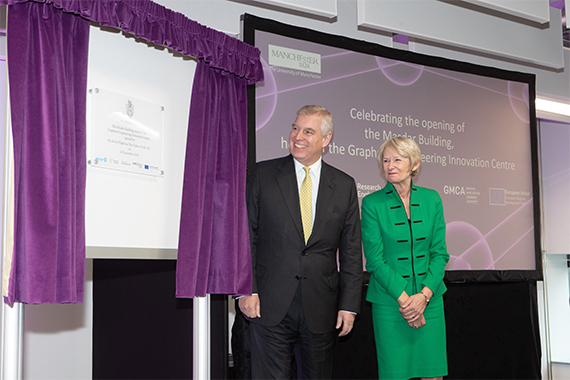More news
- Nigeria’s paint industry navigates regulatory changes and economic challenges amid p...
- Focus on the global coatings market: Global coatings market outlook
- Ask Joe Powder – October 2024
- Chinese paint majors look to domestic consumer sales as commercial real estate slumps
- Architectural coatings in Nepal and Bhutan

His Royal Highness The Duke of York has officially opened the £60m Masdar Building which houses the Graphene Engineering Innovation Centre (GEIC) at The University of Manchester IN THE UK.
HRH toured the new state-of-the-art facility in Manchester today (Monday, December 10) and met with leading academics and the University’s graphene industry partners and entrepreneurs.
The GEIC complements the National Graphene Institute’s (NGI) international research focus by concentrating on multi-faceted industry-led applications development. The key areas within the new building include; pilot productions, characterisation and material development.
The GEIC will accelerate the commercial impact of graphene and help realise its potential to revolutionise countless industries. It has been made possible by the generous support of its sponsors: Masdar, Research England (formerly HEFCE), Innovate UK, ERDF, and the Greater Manchester Combined Authority.
During the visit The Duke took in an exhibition of the latest graphene products and prototypes including; pioneering graphene-oxide membranes for water filtration, graphene composite battery panels, an innovative unmanned aerial vehicle made with graphene-enhanced carbon fibre, and a modified BAC Mono sports car with graphene-enhanced composite bodywork.
HRH, who’s three core areas of focus include; education and skills, entrepreneurship, and science, technology and engineering, met with entrepreneurs from five of the University’s graphene spin-out companies who are developing next-generation applications through the NGI and GEIC whilst establishing their own companies in Manchester. The Duke was accompanied by representatives of the University leadership team, the building’s funders and local government officials.
Speaking at the opening ceremony HRH The Duke of York said said: "It is a great pleasure to be back at The University of Manchester and to come and see the next stage in the development of graphene.
"The question I’ve been asking is, ‘how do people who are in manufacturing or other businesses know what graphene can do for them?’ or more accurately, ‘what can the new 2D materials do for them?’
"This is an excellent place for businesses who may suddenly find that graphene or a 2D material is in their interest, and just from my short visit today, the ideas seem to be limitless in how you can apply them. This is going to be a huge industrial transformation which could benefit both humankind and industry and it starts here. I wish you all every success."
Professor Luke Georghiou, Deputy President and Deputy Vice-Chancellor of the University said: "The GEIC is a first step to realising a transformation of our wider surroundings. Manchester was known around the globe as Cottonopolis at the height of the Industrial Revolution – in this century our aim is to be Graphene City – a district where 2-D materials and complementary technologies drive jobs and growth.”
Along with the NGI and the Henry Royce Institute (set to be completed in 2020) the GEIC will be crucial in maintaining the UK’s world leading position in advanced materials.
James Baker, CEO of Graphene@Manchester said: "The GEIC is a key component of the University’s strategy for Graphene@Manchester. With the ecosystem we are creating here in Manchester we can accelerate the commercialisation of real-world applications and transition graphene and other 2D materials from the lab to the marketplace. We are reaching a tipping point now where the expectations for graphene are becoming reality.”
Masdar, CEO Mohamed Al Ramahi said: "As a global renewable energy leader, we invest in technologies with untapped commercial potential. Today’s opening of the Masdar Building highlights an exciting future for Masdar, the Graphene Engineering Innovation Centre and The University of Manchester as we work together on this pioneering project over the coming months and years.”
The GEIC has already created an additional 30 jobs in addition to academics to grow the University community to over 300 graphene-related staff at the University. International partners including First Graphene have also located their European-base of operations at the GEIC and have recruited additional staff in Manchester.
Jake Berry MP, Minister for the Northern Powerhouse and Local Growth said: "I am delighted that we have been able to support the completion of the Graphene Engineering and Innovation Centre (GEIC) with £5m from the local growth fund. The innovation led by the GEIC will secure the UK’s position as the world-leader in this cutting edge technology, putting Manchester and the Northern Powerhouse on the global stage.”
The GEIC building, designed by world-renowned architect Rafael Vinoly, is 8400 square metres in size. It was built by contractors Laing O’Rourke, BBK, CH2M Hill and project managed by Arcadis.
Diana Hampson, Director of Estates and Facilities at The University of Manchester, said: "The GEIC will be home to graphene-specialist staff based at The University of Manchester, working directly alongside industry with state-of-the-art and bespoke equipment at their disposal. It will allow Manchester to build on its pioneering research and enable industry to translate that work into commercial applications.” Advanced materials is one of The University of Manchester’s research beacons – examples of pioneering discoveries, interdisciplinary collaboration and cross-sector partnerships that are tackling some of the biggest questions facing the planet. #ResearchBeacons
European Regional Development Fund
The project is receiving up to £5,000,000 of funding from the England European Regional Development Fund as part of the European Structural and Investment Funds Growth Programme 2014-2020. The Department for Communities and Local Government (and in London the intermediate body Greater London Authority) is the Managing Authority for European Regional Development Fund.
Established by the European Union, the European Regional Development Fund helps local areas stimulate their economic development by investing in projects which will support innovation, businesses, create jobs and local community regenerations. For more information visit https://www.gov.uk/european-growth-funding.



